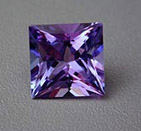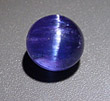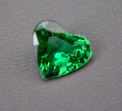

Truly a modern gemstone, transparent zoisite of a naturally yellowish brown color which can be heated to a stable blue to violet, was discovered in the shadow of Mt. Kilamanjaro in 1969. Although other varieties of opaque zoisite were well known, they made no impact on the gem market. Tanzanite's rise to prominence among retail jewelers and the general public has been rapid and dramatic. Naturally trichroic, the species shows different colors when viewed through each of its three crystal axes: blue, red-violet and yellow-green.
Although the occasional blue-violet stone is found in the rough state (Mother Nature in this case has already provided the heating); the vast majority of them must be heated to create this color. Usually stones are cut and polished prior to heating to about 700 degrees Fahrenheit, as abrasions, fractures and inclusions in the rough can cause cracking. This means that the cutter has to attempt to orient the stone for best color prior to the color change. It is the yellow-green color which is altered to colorless by this treatment leaving just the other two more attractive color axes.
Another important decision which must be made by the cutter is the choice to go for size (usually the more violet orientation yields the largest stone) or blueness (blue orientation yields smaller gems). A very small fraction of Tanzanite rough heat treats to a green or blue green color and such stones are valued by collectors. (Technically they should be called heated green zoisite, but everyone calls them "green Tanzanite" anyway.)
In the trade, all Tanzanites are assumed to be heat treated and the color is stable. Initially, blue stones were valued as a substitute for sapphire, but gradually an appreciation for the more violetish tones has built up. Tanzanite is used frequently as a ring stone, but with its hardness of 6.5 daily wear will dull the finish and its brittleness is a hazard. It is better suited to earrings, pendants, tie pins and occasional wear rings or those with protective settings. Recent disastrous weather conditions, mining accidents, government embargos and continuing political tensions have restricted the supply, especially of larger finely colored stones.
Tanzanite simulants range from less convincing glass and synthetic corundum stones whose lack of dichroism is a give away, to more convincing synthetic Fosterite pieces which must be detected by refractive index or specific gravity measurements. Recently, coated natural origin stones with micro-thin layers of rich color over pale cores have entered the market, especially in the smaller sizes 3 - 4 mm) found in cluster-type jewelry settings or as side stones.
In general, stones showing more blue are valued higher than those showing more violet and medium dark colors are the ideal. Custom cuts add value. As always, size and clarity have a strong effect on prices--> large clean rough is extremely scare, and now in addition has been limited for export, so larger, fine gems are rapidly rising in price and decreasing in availability. Collector types such as greens or the ultra-rare cat'seye stones are highly sought after and quite valuable.




